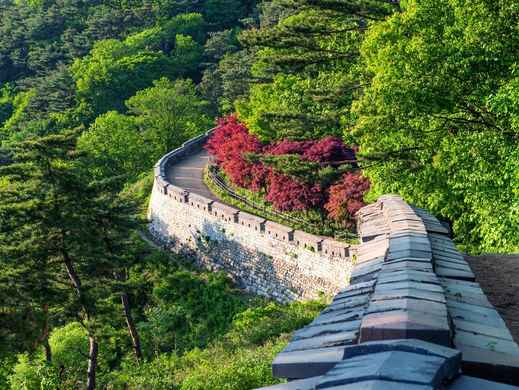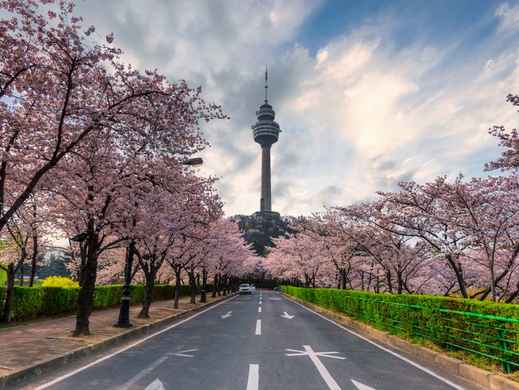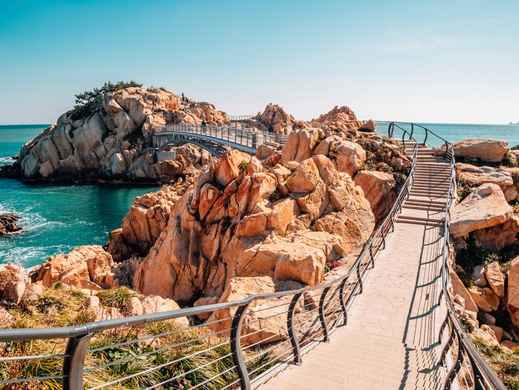


Gwangyang
Asia
/
South Korea
/
Gwangyang
Gwangyang, a city nestled in the southwestern part of South Korea, is an undiscovered jewel that offers a perfect mix of breathtaking natural scenery, industrial significance, and cultural depth. Situated in South Jeolla Province, Gwangyang is particularly famous for its robust steel industry, home to the POSCO Gwangyang Steelworks, which ranks among the largest steel plants in the world. The city’s location makes it easily accessible from other major South Korean cities. It’s just a 1.5-hour drive from Suncheon, a key city in the same province, and about 2.5 hours from the larger city of Busan. Gwangyang benefits from a well-established transportation network, including buses, trains, and nearby airports, ensuring convenience for both domestic and international travelers. As a city, Gwangyang offers a remarkable combination of industrial might, natural splendor, and rich cultural traditions. Whether you’re looking to explore its scenic beauty, delve into its industrial history, or experience its vibrant local culture, Gwangyang is a destination that caters to all interests.

Travel Tips for Gwangyang
What you need to know before traveling here
Getting Around Gwangyang
A guide to Gwangyang's local transportation
Gwangyang’s public bus system is the most accessible and affordable way to get around the city. The buses are well-connected, covering major tourist spots, shopping areas, and residential neighborhoods. The main bus terminal is centrally located, making it easy to find routes to different parts of the city. Bus schedules are generally punctual, and most buses have digital displays showing the next stop, which is helpful for visitors unfamiliar with the area.
Practical Tips for Gwangyang
Things to prepare and best way to visit
Gwangyang is home to one of the world’s largest steel plants, POSCO Gwangyang Works, contributing significantly to South Korea’s industrial prowess. The city is also famous for its annual Maehwa Festival, which attracts visitors from all over the country to admire the blooming plum blossoms. Gwangyang’s unique geographical location, bordered by mountains and rivers, makes it an ecological treasure.
One of the quickest ways to travel is by taking the KTX (Korea Train Express) from Seoul Station to Suncheon Station, the closest major station to Gwangyang. The KTX journey typically lasts between 2.5 to 3 hours. Upon arriving in Suncheon, you can easily get to Gwangyang by either taxi or local bus, which adds another 20 to 30 minutes to your travel time. For a more cost-effective alternative, you can opt for the Mugunghwa or ITX trains. However, these options are slower, with travel times ranging from 4 to 5 hours.
The city is famous for its unique style of Korean barbecue, known as Gwangyang Bulgogi. This delicacy is made from thinly sliced, marinated beef cooked over a traditional charcoal grill. Unlike other regions where bulgogi is often stir-fried, Gwangyang's version is grilled, giving it a distinct smoky flavor. Additionally, the region's proximity to the sea means that seafood is abundant and fresh, with local specialties like grilled eel and various seafood stews being popular among both locals and visitors.
For those who love nature, Baegunsan Natural Recreational Forest is a must-visit. This forest, located on Baegunsan Mountain, offers lush greenery, diverse flora, and well-maintained hiking trails. Visitors can explore various paths leading to scenic viewpoints, waterfalls, and quiet picnic spots. Mangdeok Port, situated by the Seomjingang River, is a charming spot that combines historical significance with natural beauty. The port area is ideal for leisurely walks, with scenic river views and opportunities to observe local fishing activities. For panoramic views of Gwangyang-si and its surroundings, Gobongsan Observatory is the place to be. Located on Gobong Mountain, the observatory provides breathtaking views of the city, the bay, and the distant mountains. The observatory is accessible via a scenic drive or a moderate hike.
While English signage is common at major tourist spots, learning a few basic Korean phrases or having a translation app can be useful, especially when using public transportation or interacting with taxi drivers. Gwangyang’s climate varies by season, so dress appropriately for the weather, whether it’s the chilly winters or the hot and humid summers.
See All Practical Tips for Gwangyang

Get to Know Gwangyang
Take a tour of this destination's highlights

Travel Tips for Gwangyang

Get to Know Gwangyang













 Facebook
Facebook Instagram
Instagram TikTok
TikTok Youtube
Youtube Twitter
Twitter Telegram
Telegram WhatsApp
WhatsApp
